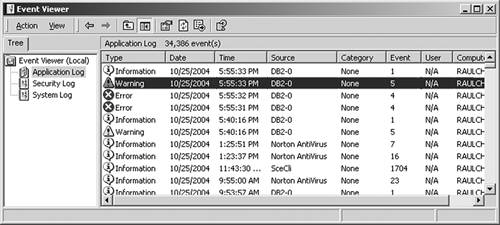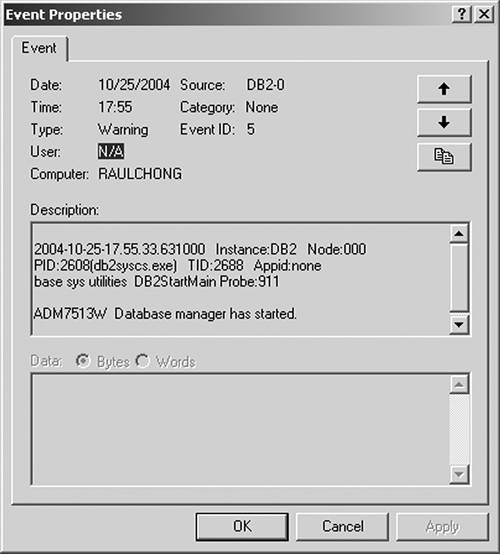Section 17.4. DB2 First-Failure Data Capture
17.4. DB2 First-Failure Data CaptureFirst-failure data capture (FFDC) is a general term applied to the set of diagnostic information that DB2 captures automatically when errors occur. This information reduces the need to reproduce errors to get diagnostic information. The information captured by FFDC is stored in the following files. (The DIAGPATH Database Manager Configuration parameter specifies the location of these files.)
17.4.1. The Database Manager Configuration Parameters Related to FFDCThe following Database Manager Configuration parameters are related to FFDC:
17.4.1.1 The DIAGPATH ParameterThe DIAGPATH parameter specifies the fully qualified path in which DB2 puts the FFDC information. The default value for DIAGPATH is a null string. We recommend that you keep this default value. If you choose to change the value, we recommend that you use a centralized location, especially if there are multiple database instances. When the value of DIAGPATH is a null string, the FFDC information is placed in the following locations.
We recommend that you clean out the DIAGPATH directory periodically to keep it from becoming too large. 17.4.1.2 The DIAGLEVEL ParameterThe DIAGLEVEL parameter specifies the type of diagnostic errors that will be recorded in the db2diag.log file. Table 17.2 lists the valid values for this parameter. The default level is 3. Increase the level to 4 if you want more information. However, be aware that the db2diag.log grows very fast at the 4 level due to the large amount of information logged.
17.4.1.3 The NOTIFYLEVEL ParameterThe NOTIFYLEVEL parameter specifies the type of administration notification messages that are written to the administration notification log. On Linux/UNIX platforms, the administration notification log is a text file called instance.nfy. On Windows, all administration notification messages are written to the Event Log. The errors can be written by DB2, the Health Monitor, the Capture and Apply programs, and user applications. Table 17.3 lists the valid values for this parameter. You might wish to increase the value of this parameter to gather additional problem determination data to help resolve a problem.
17.4.2. db2diag.log ExampleThe following is an example of a db2diag.log entry at a diagnostic level of 3: 2004-06-01-18.30.19.884359-240 I1179921C311 LEVEL: Event PID : 163880 TID : 1 PROC : db2star2 INSTANCE: db2inst1 NODE : 000 FUNCTION: DB2 UDB, config/install, sqlfLogUpdateCfgParam, probe:30 CHANGE : CFG DBM: "Instance_Memory" <automatic> From: "3394" To: "2405" Here is a breakdown of the entries in this db2diag.log:
The last part of the message entry is a message that often includes error codes, page dumps, or other detailed information. Sometimes this information will be complex, but usually it will give you an idea of the type of operation that is causing the failure, along with some supporting information to help the investigation. 17.4.3. Administration Notification Log ExamplesThe following is a sample administration notification log entry in the notification log on a UNIX system: 2004-06-01-18.30.22.941721 Instance:sylviaq Node:000 PID:163880(db2star2) TID:1 Appid:none base sys utilities DB2StartMain Probe:911 ADM7513W Database manager has started. You interpret these entries the same way as you do the entries in the db2diag.log. This message is logged when the Database Manager Configuration parameter NOTIFYLEVEL is set at 3 and indicates that the instance has started. On Windows, you need to open the Windows Event Viewer to view the DB2 administration notification log entries. From the Windows Start menu, choose Administrative Tools > Event Viewer. Figure 17.5 shows the Windows Event Viewer. The DB2 messages are displayed along with messages from other applications. The DB2 messages in the figure are displayed as DB2-0 (where DB2 is the instance name and 0 represents the partition number) in the Source column. Figure 17.5. The Windows Event Viewer The entry highlighted is a DB2 message at warning level. Double-click on it to display the entire message, as shown in Figure 17.6. Figure 17.6. DB2 administration notification log entry on Windows
|
EAN: 2147483647
Pages: 313
